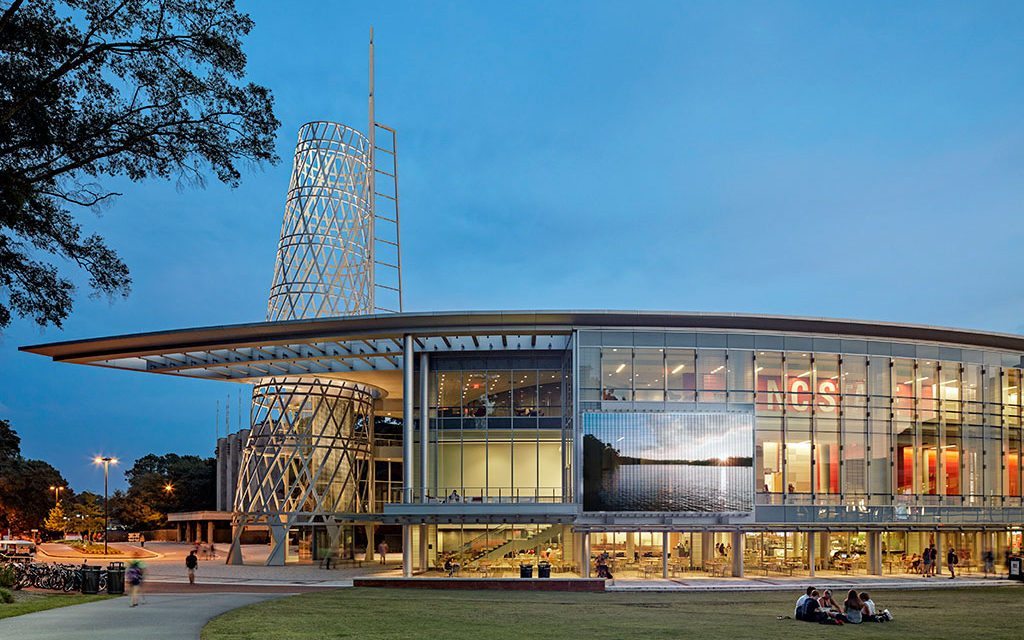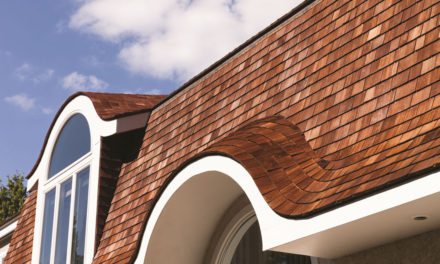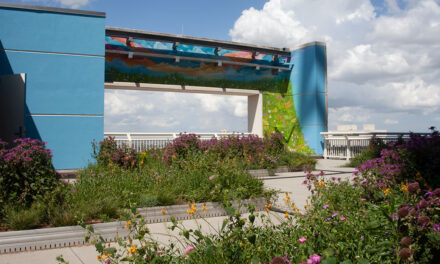As architects, designers and facility managers seek to transform the traditional and staid façades of educational facilities into dynamic, vivid communication mediums, they have increasingly turned to transparent media façades constructed of metal mesh. While metal mesh and metal fabric have been used for decades in institutional architecture and design, it is only recently that the A&D community has begun to incorporate media-enabled products into college campuses around the country.
Dynamic façades work well in large-scale applications and can cover sizeable existing surfaces while using significantly less electricity than traditional electronic billboards. Plus, thanks to a high level of transparency, these façades allows for natural daylighting and ventilation to reach the buildings surface. This makes it ideal for facilities such as libraries, student centers and mixed-use buildings that seek to provide a positive interior ambiance and a transparent connection with the outside world. It also reduces running costs compared to traditional billboards.
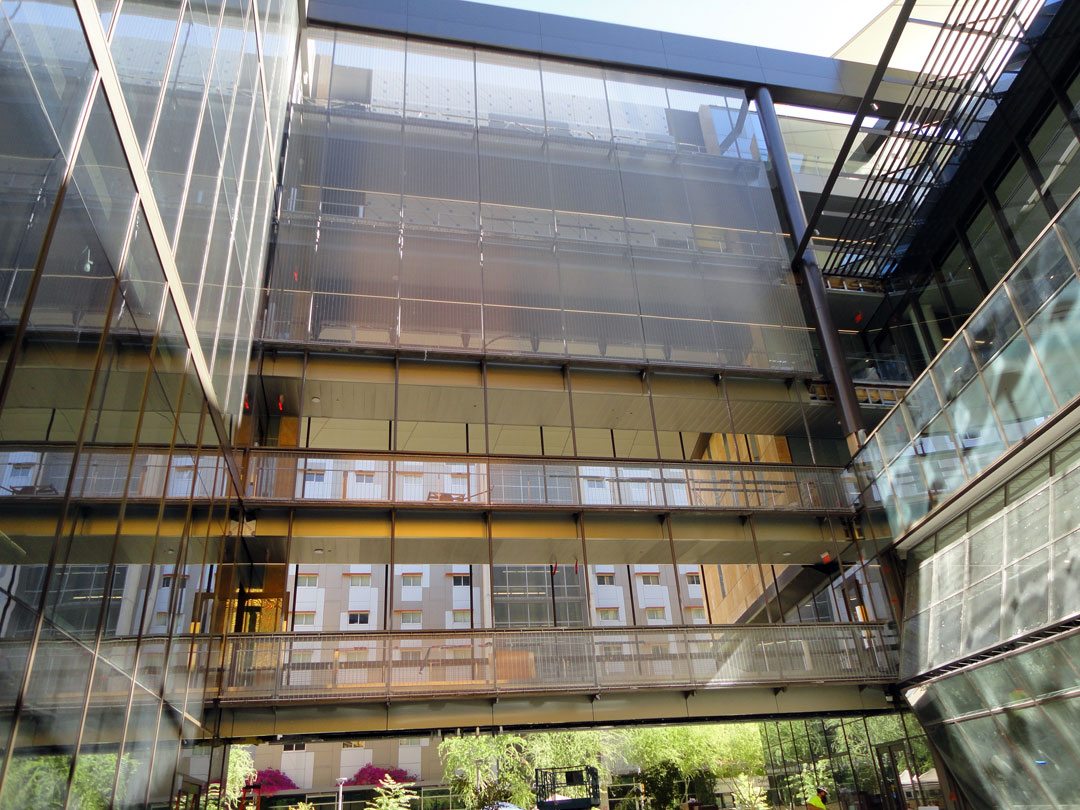
Arizona State University. Photo: © GKD-USA, Inc.
Primarily made of stainless steel metal fabric, media façades feature the fundamental qualities of woven metal – durability, aesthetics, transparency, flexibility and security – with unprecedented artistic and communicative capabilities. Companies often partner with LED manufacturers and technology companies to create the high quality, durable and reliable solutions.
GKD, for example, works with the world-leader in large-screen video technology Daktronics to manufacture its Mediamesh® product. Mediamesh is specifically designed to allow for thin, horizontal LED profiles to be placed at custom vertical intervals within the mesh, Mediamesh makes it possible to balance transparency and display resolution on a project-to-project basis:
• Vertical resolution is adjustable in 10 mm increments from 40 mm spacing and up
• Horizontal resolution is fixed at 50 mm pixel spacing
• LED profiles can be tilted downward up to 20 degrees to better target viewers below
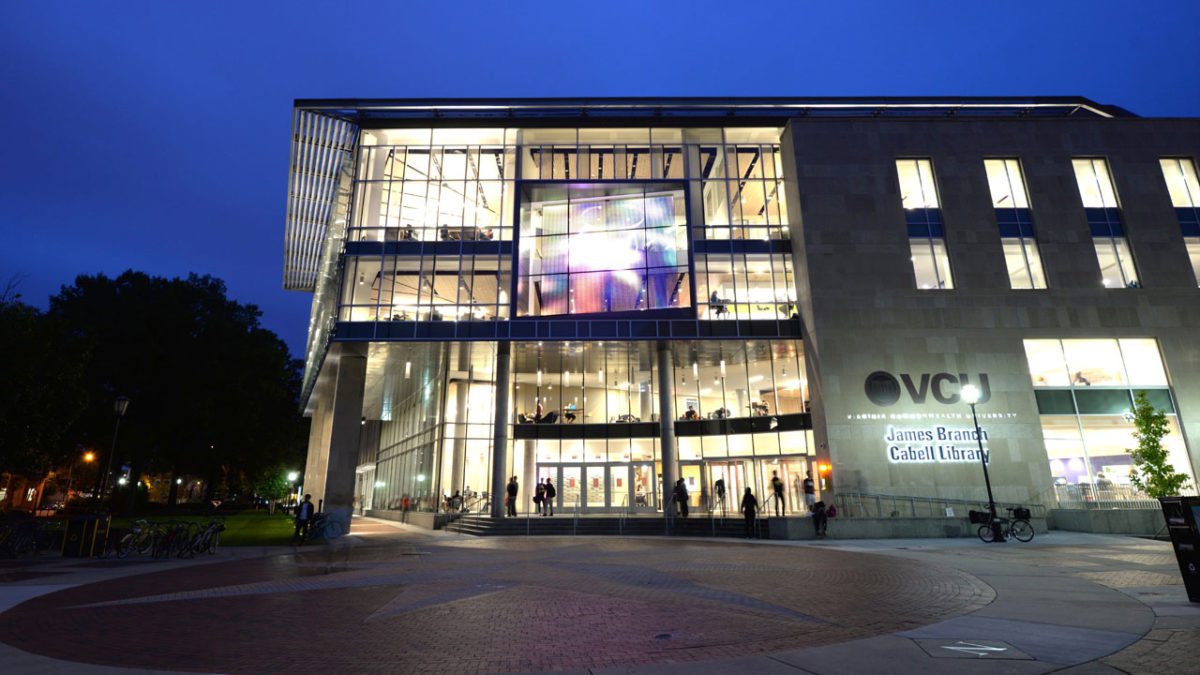
Virginia Commonwealth University. Photo: © 2016 Mark Rhodes
Featuring new electronics that are up to 60 percent brighter than previous iterations, Mediamesh also boasts an exceptionally deep color palette (1.07 billion colors) and superior motion reproduction (3,800 Hz scan speed). Coupled with a photocell option that measures ambient lighting conditions and automatically adjusts display brightness, its clear to see why Mediamesh has become an effective tool in capturing the attention of constantly distracted millennials and other target audiences around the country.
A UNIQUE DESIGN & INSTALLATION PROCESS
GKD offers an expert team of in-house designers, fabricators and installers, so architects and designers are able to create a variety of custom solutions for multiple types of building façades. The company prides itself on being a turnkey operation, where it’s never too early to be involved in a project. Once a design has been realized and produced, two types of installation options are available:
-
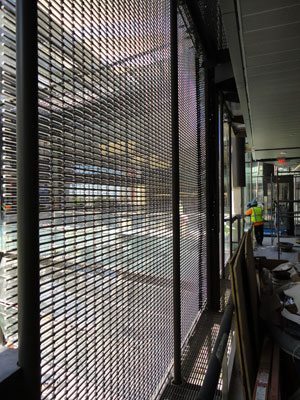
Arizona State University. Photo: © GKD-USA, Inc.
Woven-in-bars with eyebolts top and bottom. A stainless steel round bar is inserted into the metal fabric in place of weft wires. Eyebolts are attached to the round bar and are secured to brackets top and bottom, and are tensioned by turnbuckles or nuts. The size of the round bar and frequency of the eyebolts is determined by tension loads. Intermediate pivoting brackets are spaced vertically and horizontally as needed and also connect to the mesh.
- Woven-in-bars with hooks at the top and eyebolts at the bottom. Tensioning is accomplished via eyebolts at the bottom connections where woven-in-bars pass through the mesh and eyebolts. At the top, the round bars are cradled in specially designed brackets. Intermediate pivoting brackets are spaced vertically and horizontally as needed and connect to woven-in-bars in the mesh.
- Flats and Clevis. Both ends of the fabric are clamped by flat bars. Clevises with threaded rods are added for tensioning by turnbuckles or nuts. With its clean, finished appearance, this system works well for rigid and flexible metal fabrics.
From conceptualization to occupied space, GKD is an asset that brings a wealth of knowledge and experience to projects big and small. Additionally, representatives work directly with general contractors to streamline the installation process. In a world where timelines and budgets are tighter than ever, this dedication to excellence helps alleviate stress and provides GC’s and subcontractors with peace of mind.
Virginia Commonwealth University
James Branch Cabell Library
Based on its unique design process, design flexibility, performance and wow-factor, it’s no wonder that Mediamesh is appearing on college campuses and university buildings around the country. The Virginia Commonwealth University (VCU) James Branch Cabell Library project (left) is a shining example of this, beckoning students into a building that is finding it hard to stay relevant in an increasingly digital world.
Covering a total area of 400 sq. ft., the transparent media façade at VCU is composed of two panels, each measuring 19 x 10.5 feet. The rigid panels are attached with woven-in-bars with eyebolts for a seamless appearance. Although the screen is installed on the interior of the building, it is viewed from the exterior, providing a focal point from multiple places on campus.
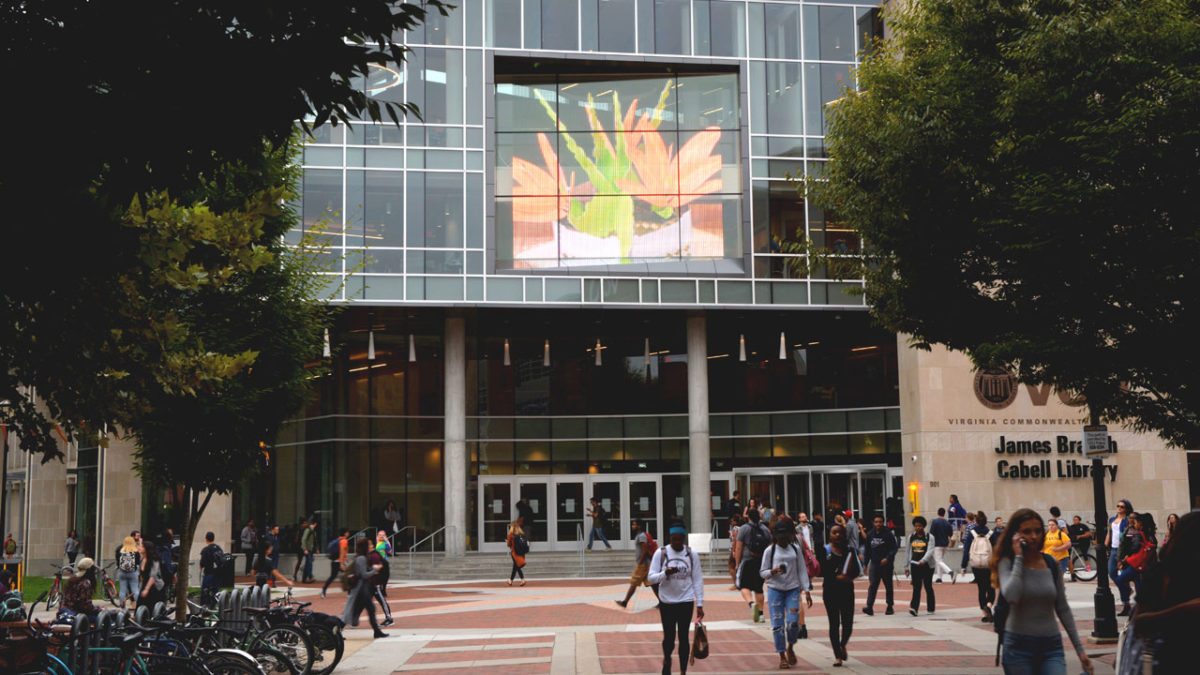
Virginia Commonwealth University. Photo: © 2016 Mark Rhodes
Before construction began, GKD completed initial concept and technical drawings, met with contractors and walked with the building owners to discuss specific cable routs running from power equipment to the Mediamesh façade. Despite several meetings, when GKD got to the job site, they found that the contractor’s team had put half a dozen bends in the conduit. There was no way for GKD to thread the cable, and they had to work to reroute it.
While the team ended up losing several days in the installation process, GKD added time to its installation shifts to make sure the cable could get pulled in as quickly as possible.
Beyond issues with the conduit, the installation team had to develop specialty equipment and lifting systems to work around a functioning library. The fourth floor, where the Mediamesh install took place, was a private, no-noise think tank for doctoral students. To respect this need for sound control, through smart planning and effective systems they were able to work around the library and student’s schedule.
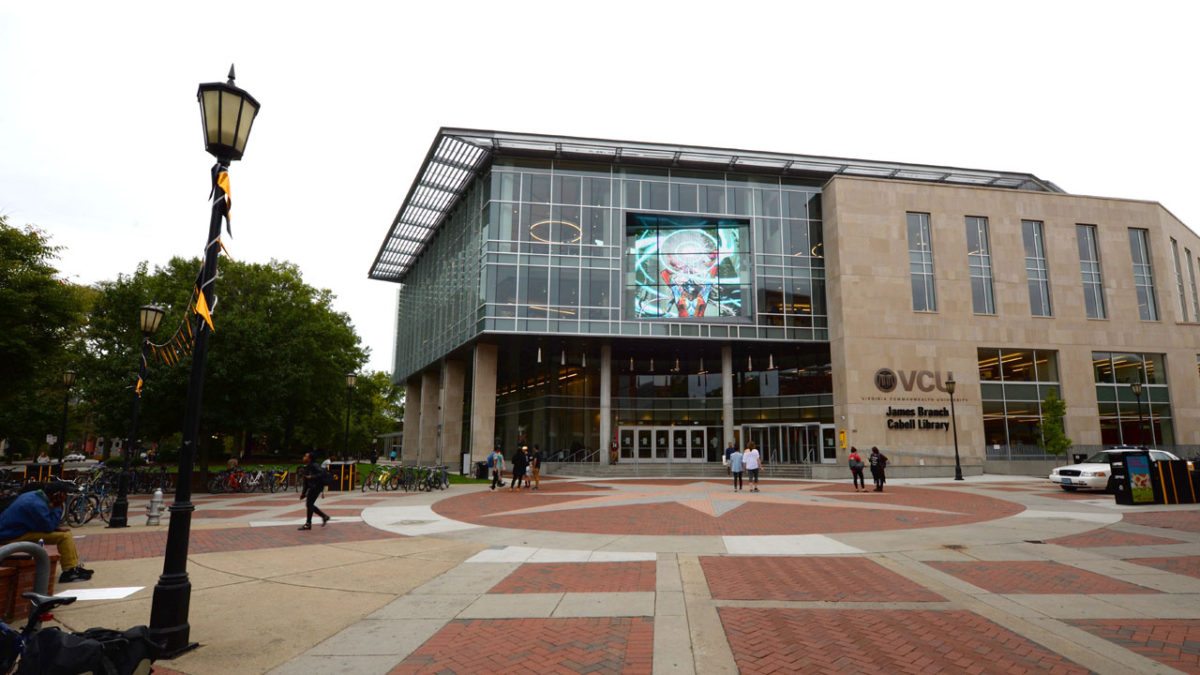
Virginia Commonwealth University. Photo: © 2016 Mark Rhodes
North Carolina State University
Talley Student Center
Fundamentally different than the installation at VCU, the North Carolina State University (NCSU) Talley Student Center project includes a flexible, exterior façade that serves multiple purposes for the campus. Being a new building, the Talley Student Center also allowed the team at GKD to work with the architect and general contractor from the concept stage through final installation and quality checks.
Three exterior panels join together to form a 565 sq. ft. façade over the existing curtain wall of the student center. Attached using woven-in-bars with eyebolts top and bottom, the installation is the only flexible, transparent media façade in use. This allows students inside the building to have uninterrupted views of the expansive university quad, and allows the screen to seamlessly blend in with the architecture of the building.
The NCSU project utilizes Mediamesh in clever and community-building ways. Not only can students watch movies on the 18 x 32 ft. screen from the grassy quad, a hidden surround sound system is linked to the video providing high quality audio.
The screen and accompanying system can also switch between eight different units and uses, including live video streaming, static images, important ticker messages and more, all connected to an internal server.
Vibrant and attention grabbing, the installation at NCSU provides students, faculty and staff with a central focal point and source of entertainment for years to come. From community gathering events to providing important safety announcements and news updates, the uses are nearly endless.
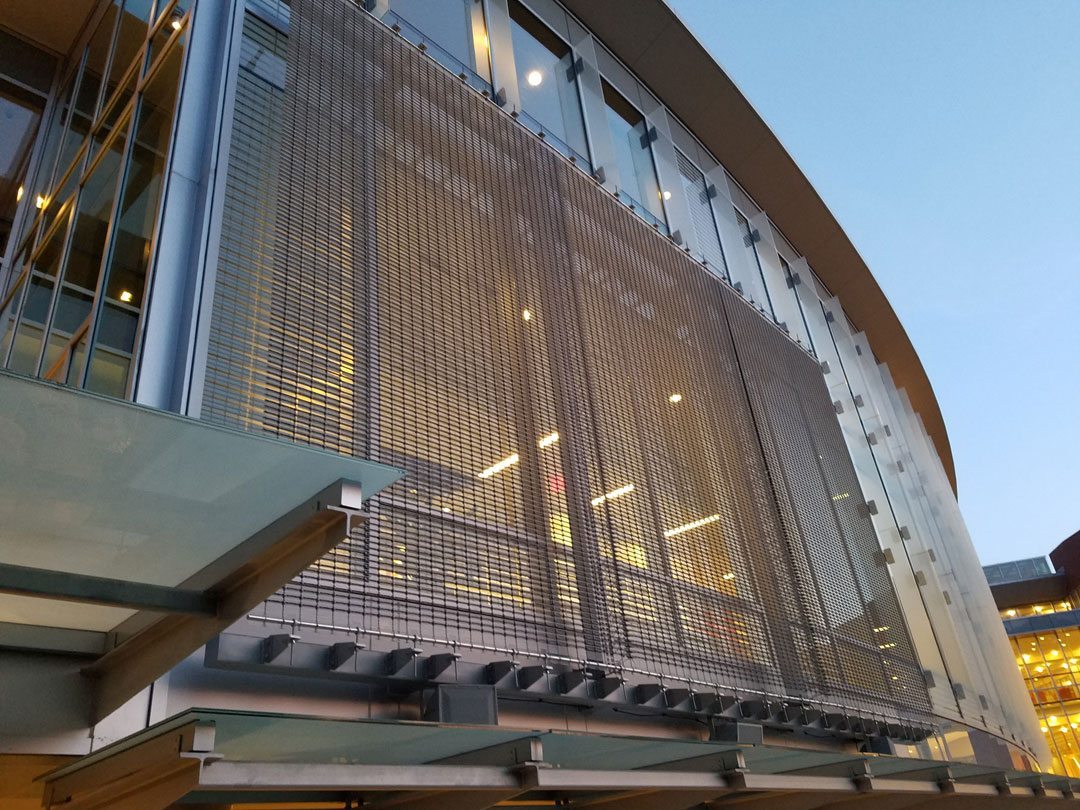
North Carolina State University. Photo: © Builders
Arizona State University
Center for Law & Society Downtown Campus
A combination of the VCU and NCSU projects, the Arizona State University (ASU) Center for Law & Society’s Downtown Campus installation features a rigid Mediamesh façade installed on the exterior of the building. However, the ASU job blends a Mediamesh façade with a mandatory safety function.
Together, the Mediamesh and Tigris products act as fall protection as well as a seamless and transparent media system. Combined, these products cover 7,000 sq. ft. of the building, with Mediamesh accounting for 760 sq. ft. of the installation.
Like NCSU and VCU, the products used help create a transparency that lends itself well to the overall design aesthetic of the building, while providing a nod to the critical need for transparency in the field of law and criminal justice.
With a variety of images and video being broadcast to arriving students, researchers, faculty and guests, the installation at ASU provides visual impact and stimulus to an otherwise static and corporate-feeling educational space. See Mediamesh in action here.
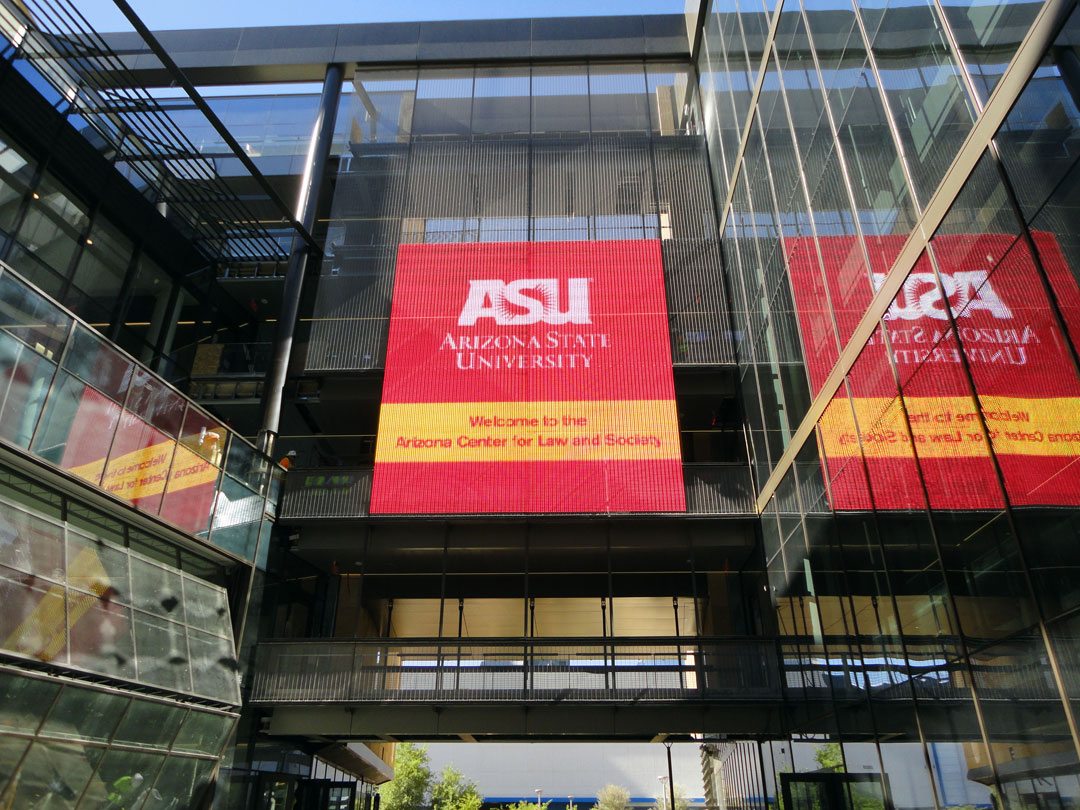
Arizona State University. Photo: © GKD-USA, Inc.

